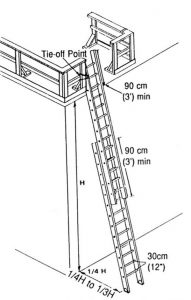12 Ladder Safety
Portable Ladder Safety
Portable ladders must meet CSA standards, Grade 1 or 2 (Grade 3, or household grade ladders, are not acceptable in the workplace).
Always inspect a ladder before use. Are the rungs slippery? Check steps, rungs, rails & braces for damage. Check for loose screws, bolts, hinges & other hardware. Check the locks on extension ladders. Check safety feet and wheels.
Set the ladder up on a solid, level surface. Keep area around the base uncluttered. Use a spotter or barricade if set up in traffic area. Be aware of nearby doors.

SAFE LADDER PRACTICES
-
-
- Always face the ladder.
- Maintain adequate contact with the ladder (3 points of contact).
- If you need tools, carry them in a tool belt or raise and lower them with a hand line.
- Never climb higher than the second step from the top on a stepladder.
- Don’t work from the top 3 rungs of a straight ladder.
- Never reach too far to either side or to the rear (keep your belt buckle between the ladder rails).
- Use fall protection when the risk of fall is unacceptable.
-
Different types of ladders are designed to keep you safe and productive when working from them. The most common types are stepladders, platform ladders, single ladders and extension ladders. Using the wrong type of ladder or ignoring their limitations can result in serious injury.
NS regulations require that where there is a risk of contact with live electrical conductors, ladders must be non-conductive (i.e. aluminum and other metal ladders would not be acceptable for this use).
The height of the ladder is an important safety consideration. A person’s maximum safe reaching height is approximately 4 ft. (1.2 m) higher than the height of the ladder. For example, a typical person can safely reach an 8 ft. (2.4 m) ceiling on a 4 ft. (1.2 m) stepladder.
Ladders are designed and constructed to safely support up to a maximum amount of weight. CSA Z11 recognizes three grade classifications: Grade 3 includes ladders with 200 lbs. (91 kg) maximum load capacities. Grade 2 is for ladders with 225 lbs. (102 kg) maximum load capacities. Grade 1 includes ladders with maximum load capacities of 250 lbs. (113 kg) and above. A person’s fully clothed weight plus the weight of any tools and materials that are carried onto the ladder must be less than the ladder’s maximum load capacity.
NS regulations require that where there is a risk of contact with live electrical conductors, ladders must be non-conductive (i.e. aluminum and other metal ladders would not be acceptable for this use).
The height of the ladder is an important safety consideration. A person’s maximum safe reaching height is approximately 4 ft. (1.2 m) higher than the height of the ladder. For example, a typical person can safely reach an 8 ft. (2.4 m) ceiling on a 4 ft. (1.2 m) stepladder.
Ladders are designed and constructed to safely support up to a maximum amount of weight. CSA Z11 recognizes three grade classifications: Grade 3 includes ladders with 200 lbs. (91 kg) maximum load capacities. Grade 2 is for ladders with 225 lbs. (102 kg) maximum load capacities. Grade 1 includes ladders with maximum load capacities of 250 lbs. (113 kg) and above. A person’s fully clothed weight plus the weight of any tools and materials that are carried onto the ladder must be less than the ladder’s maximum load capacity.
